Belgium/Luxembourg – May/June 2012
Now, while I’m no monarchist, equally I’m not a republican either. However, a combination of 50 years of Queen Elizabeth II’s rule which moved the Late May Bank Holiday to June, and added a second ‘celebratory’ one the day after, coupled with my new boss refusing to allow me to work Bank Holidays any more, for reasons that I don’t completely understand or agree with, meant that I had an opportunity to leave the country for a few days to somewhere that might actually be *open*.
By booking a couple of days off either side, it meant I could snaffle a week somewhere, but where to go? It needed to be somewhere easy to explore in such a short time, and therefore ought to be close by (if I went anywhere far away I’d need to do it justice by staying for a while!). And for once, one candidate jumped out as being almost perfect. I realised that while I’d been all around the world, I’d never set foot in our third closest foreign country. I’d been through it by coach, but I’d never properly been to Belgium! Cue howls of derision from my work colleagues. When discussing other future holiday destinations, I was asked: “Don’t you ever go anywhere normal?”. My response of: “But I’m going to Belgium in June!” was countered with “That doesn’t count!”.
Belgium: home to beer, chocolate, fries, World War I memorials, and … holding the record for the longest period of time without an *official* functioning government (589 days), for quite complicated and uniquely Belgian reasons. But Belgium is quite a unique country …
In addition, because it’s there and close by, and because I have the ambition to visit every capital city in Europe, I figured I might as well pop across the border to Luxembourg, one of the world’s richest countries and famous in Belgium for being where people fill their cars with petrol …
The reason for the journal’s title is because I’d been training for the Sheffield Half Marathon, but earlier on in May I’d developed an injury during training – something akin to Shin Splints – and so had to resort to walking with a stick for a few weeks to provide me with a bit of extra support.
| Day 0 : Just Visiting!
Day 1 : Two Languages, One Quirky Place |
Day 4 : Sandwell and the Ninth Art |
Day 0: Wednesday 30 May –
Just Visiting!
Left work at 4pm, came home, packed (!), and then waited for a taxi. I say “packed”; to be honest all I had to do was throw some clothes into a rucksack and top up with a couple of electrical items, some paper, and a couple of books. Decided to take the big rucksack rather than the small backpack, partly just in case it rained so I could take my coat.
At this point I ought to give big and surprising thanks to my neighbour who not only accidentally picked me up from work (I was waiting at the bus stop as she drove past, unexpectedly), but also drove me to the station (because she was going out again as I was waiting for my taxi!).
Caught train to Nottingham nicely. My train to Grantham was delayed (why am I going that way? Because it was £11 as opposed to £30-odd …) so missed the connection to London; fortunately the *previous* train was delayed by an hour so I only had to wait about 40-odd minutes. In the intervening time, helped out a would-be traveller who was heading north to Newcastle who’d missed *her* connection too and was all in a muddle – I got her onto a train to Doncaster cos at least it’s more interesting than Grantham …
Nice journey down to London – it’s not a route I normally take – and there were some pretty sceneric effects near Welywn Garden City/Hitchin where low-lying mist lay over some town parklands creating a kind of mystical atmosphere. Then we hit the London suburbs and it all evaporated, meh.
Was staying in a backpacker hostel (because it was £21/night, and 10 minutes from St Pancras Station!); I’d stayed in it before a couple of years ago when I went to the USA. It’s called ‘Clink78’ and so for instance the TV/common room is decked out a bit like a courtroom, with identified spaces for ‘Press’, ‘Defendant’, ‘Judge’ etc, and some of the rooms are structured a bit like cells. I didn’t do a lot in the evening though – mainly sat outside reading the travel guidebook and doing a spot of planning. My only problem with the place was it was too hot inside – no air-conditioning, few open windows, and lots of people. Managed to sleep anyway!
Day 1: Thursday 31 May –
Two Languages, One Quirky Place
That said, I didn’t sleep *that* well – needing an early start didn’t help my thought process. It’s amazing how often that happens – when I need to wake up early, I rarely get any sleep at all. No idea why that happens.
Anyway. No problems catching the Eurostar at silly o’clock. Slightly disappointed that the ‘new route’ from St Pancras goes in tunnels for much of the journey through London, as opposed to the ‘old route’ from Waterloo which allowed views of much of the London suburbs. Still, it’s quite a swift route – feels like it takes virtually no time at all to get to Ebbsfleet, never mind Stratford! (Not that I’m sure Stratford International is open yet; always weird to speed through a perfectly-formed empty station!).
Arrived at “Brussels South” station slightly early, and no customs or immigration meant you could just walk out into the main part of the station. Found my connection to Bruges, although it was running about 7 or 8 minutes late. In general, “Brussels South” station looks actually a bit ‘naff’; a bit haphazard and grubby.
[The *name* of the station is one small example of the strange, fake, country that Belgium is: The Walloon French call it ‘Bruxelles-Midi’, while the Flanders Flemish call it ‘Brussel-Zuid’. Both names are equally valid, and used, not interchangeably, but actually at the same time. The road names are similar; so one of the main North-South roads in the centre of the city is called ‘Boulevard Anspach’ *and* ‘Anspachlaan’. Fortunately French puts the translation of ‘Road’ before the name, whilst Dutch puts it after, so most of the road name signs are, for example, ‘boulevard ANSPACH laan’. It’s part of what’s known as the ‘Belgian Compromise’, whereby you have what effectively function as two (three if you count Brussels, four if you count the German majority area in the far East of Wallonia) separate countries operating under a unified whole, and politics, television, entertainment, education, etc is all operated separately in Flanders to Wallonia. Just don’t start a discussion on Brussels-Halle-Vilvoorde; even the Belgians have trouble with that debate …]
Today and tomorrow are Flanders days. Flanders is the Northern bit of Belgium; traditionally agricultural and relatively poor (as opposed to the Industrial South of Wallonia), but over the last couple of decades has seen a massive increase in tertiary sector activities like tourism and banking, which has changed the balance of power in Belgium quite significantly. The majority language in Flanders is Flemish/Dutch, although English, German, and even French, are quite widely understood and spoken. The other thing to say about Flanders, based on the train journey to Bruges, is that it’s fairly flat – the only hills are railway embankments!
So, Bruges. Made sure I could draw money out (it would have been a bit of an issue if I hadn’t been able to!, but at least I warned my bank this time!), then took a scenic walk along the outer canal ring to the hotel. There’s a cycle-path and what amounts to a ‘linear park’ running right next to the canal, and the road on the inner side is quiet and lined with cobbled pavements and stone terraced housing. It was all quite quiet.
The hotel was … quirky. I’d found it online, and mailed them to ask if they had any rooms (usually I’d look on TripAdvisor or some such, but Bruges was proving expensive). It turns out that it’s kind of not really a hotel at all, but rather two rooms in someone’s three-storey town house. They brew their own beer (which was fab) and wine (which I didn’t try because I don’t mix drinks!). In addition, the rooms and hallways are decorated with … whatever they’ve found that people haven’t wanted, in an almost Womble-esque fashion. There were magazines and sheet music on the walls, mannequin heads lined up underneath the sinks, religious sculptures on the stairs, and frankly quite odd miscellanea scattered around. To cap it all, in the other bedroom, there was a toilet whose light-switch was wired in to the radio, so if you went in and turned the light on, the radio came on … Why yes, I *would* stay there again, but it’s not a guesthouse to everyone’s tastes! LOL!

The other walls were weirder!
Anyhoo, into Bruges town. There’s no denying it, it’s a touristy place. However the tourists tend to stay very much in the centre – the Grote Markt and Burg squares are lined with street cafés and visited by horse-and-carriage trip vendors etc. That said, it *is* a pretty place, with small alleyways lined with old buildings, and pretty stone canal bridges. Obviously lots of tour groups, but again they tend to stay within the centre – a few minutes’ wander and you can feel like you have the whole town to yourself.
Lunch consisted of a chocolate-covered waffle, followed an hour or two later by a Croque-Monsieur variant (Croque Boum-Boum – cheese, ham, and bolognaise sauce). The day mainly consisted of slowly ambling around the town, with short rests every now and then – partly due to leg issues and partly due to fatigue (I simply didn’t fancy going round museums; in any case, here in Bruges, the town itself is the most appealing thing to see).
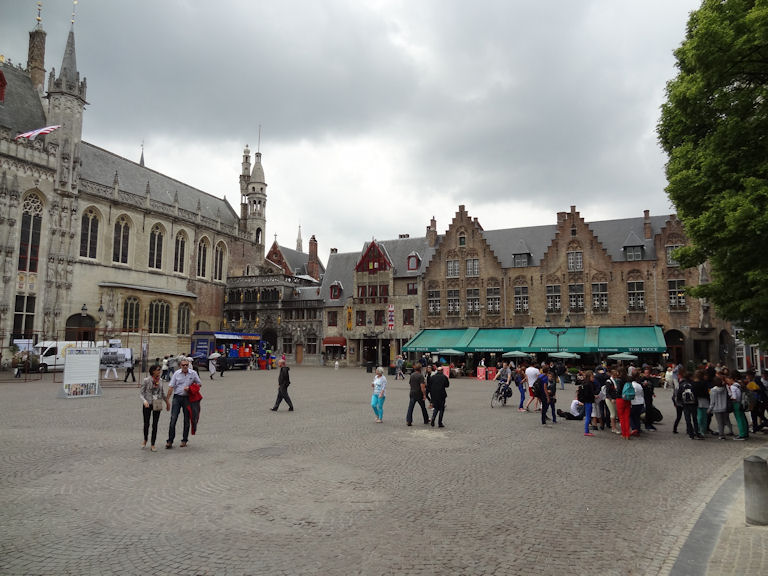
Bruges. Complete with tourists.
I did eventually manage to find the decent bar highlighted in the guidebook – de Garre – hidden away down a pokey alleyway off the main street between the two squares; unadvertised, low-key. Nice place though; the beer menu was 4 pages, and that’s not including the Trappists and the fruit beers! Beer served with small pieces of cheese – presumably to ‘cleanse’ the palate between drinks.
After going back to the hotel for a rest and quick doze, I came back out again around 8pm to source an evening meal. The town centre was more-or-less empty, which was quite a strange feeling – guess the day-trippers had either gone back home or were staying in hotels somewhere cheaper than Bruges. I actually didn’t feel that hungry in the end, so had the traditional Belgian standby of ‘frites with sauce’, along with a small chunk of deep-fried local cheese. Wandered back to the hotel down deserted cobbled streets; it felt like it was actually a very safe town to walk through!
——————————————————————————
Today’s beer-tasting notes:
de Garre : Very rich, very hoppy, and quite flowery. Lager-esque, but full-flavoured with it rather than being bland and metallic. Interestingly, maybe 90% of people in the pub were drinking it!
Pannepot : 10%!. Claims to be made with ‘candy’ as well as spices. Rich, roasted chocolate aftertaste which hits after about 2-3 seconds. There is a little ‘spice’ taste, possibly turmeric.
Day 2: Friday 1 June –
… But there *are* no poppies!
Today I changed my travel plans, primarily because I’d brought my rucksack, but also because I was quite liking the hotel. I’d originally planned to spend a night in the Western town of Ypres, but I decided to cancel that booking and merely make a day-trip of it. [I had to use their computer rather than my phone as I was having problems connecting to their Wi-Fi]. In addition, there was only a small window of time to check-in at the other hotel, and it was a bit out-the-way, and I couldn’t guarantee being anywhere near it in the window.
Marjan (the landlady) drove me to the station and we had a chat about beer and Belgium – interesting and convoluted place! I arrived at the station just as my train was timetabled to leave, so had a wait of about half an hour, which passed quite quickly actually. I was headed to the obscure town of Roeselare, south of Bruges, to pick up a bus to get me to the small village of Zonnebeke.
Now, history hasn’t been kind to Zonnebeke. And, worse still, no-one’s ever heard of it. However, the neighbouring village of Passendale is much more famous. For cheese-making. [Although even that’s nearer Zonnebeke!]. Well, that, and a small military skirmish that barely trouble modern historians …
My first stop, in a field just off the main road, and up a “hill” (slight incline!), was the Tyne Cot Cemetery. Some 12,000 white markers in (mostly) regimented lines standing stiff above the green grass, stark against the blue sky and firm against the slight breeze. Each one marking the last resting place of a young soldier who fell fighting at a time when the ground was brown and thick with mud, and the sky was punctuated with the incessant sound and sight of artillery flying overhead. From both sides.
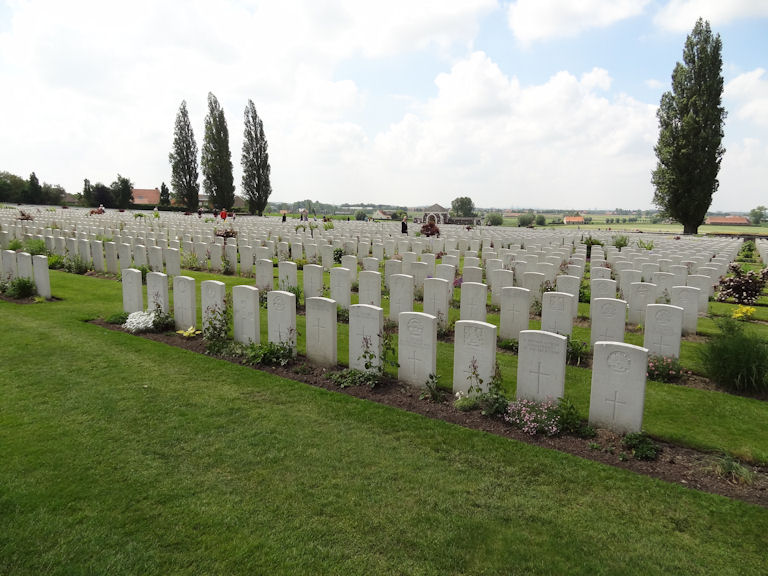
After the Last Waltz …
Just under 12,000 graves. And these are where the bodies could be found. Around the far side of the cemetery is a semi-circular wall that lists, by regiment, just under 35,000 names of people who died in action and whose bodies couldn’t be found. What makes this even more incredible is that these 35,000 names are actually the ‘leftovers’ – the ones that couldn’t fit on the Menin Gate in central Ypres (just under 55,000). So that’s 102,000 remembrances 102,000 soldiers who never came back. On walking towards the small visitor centre at the entrance, a clear female voice reads out simply the names and ages of those who lie here. Chilling.
Now consider this: This is *only* the British and (some) Commonwealth troops. New Zealand, Australia, Canada, France, etc have their own memorials to the fallen. Tyne Cot is not the only cemetery A few miles North West (I didn’t get there), in the village of Langemark, is the equivalent German cemetery, with over 40,000 bodies interred. And smaller cemeteries are dotted around all over the area; more than a handful are passed by the bus between Tyne Cot and Ypres alone. Some of them are quite small, some of them are reasonably large, but all of them are the same; reflective places on the strange things that humans will make other humans do in the name of a Greater Good <Sarcasm>.
[Historical note : fighting was so fierce here in World War I because of the strategic importance of the Ypres area. Close to a couple of important railway supply lines, and, because much of the rest of this part of Northern Europe is flat, contains some important higher ground. If the Germans could get through here, there’d be nothing stopping them reaching Calais. If the Allies break through, then they could easily march on Brussels and into Germany beyond. Neither side could and, following initial fighting in late 1914, the front line didn’t move more than a few hundred meters for most of the next four years.]
From Tyne Cot I hopped on the bus a couple of stops to Zonnebeke town centre, to visit the “Passchendaele 1917” Museum. It’s an interesting place; the main exhibits are a collection of items and lots of information (including newspaper cuttings from all countries involved) all about World War I in general and the battles around Ypres in particular. What’s most interesting was going down some steep stairs (a bit hairy with a stick! The lady in the entrance guided me towards the lift up on the way in, but I chose to then go down the steps at the end rather than head back to the lift!) into a full recreation of life in a trench, including seeing the sleeping quarters, medical rooms, etc, all the time with a background soundtrack of shelling. The roof was a bit low so someone like me would have had some trouble being there for any lengthy period of time.
After Zonnebeke, I had a chocolate chaud (sorry, ‘warme chocomelk’) in the museum’s café before hopping on the bus to Ypres town centre. The bus actually passes through the Menin Gate on the way in (although interestingly not on the way out). Ypres is another small town with a very large main square. It was pretty hot by this point (the electronic indicator outside a shop said 28ºC) so I had a slow wander through the town (taking a look at the Menin Gate) before heading back to the square for a little drink – mini-biscuits rather than cheese this time.
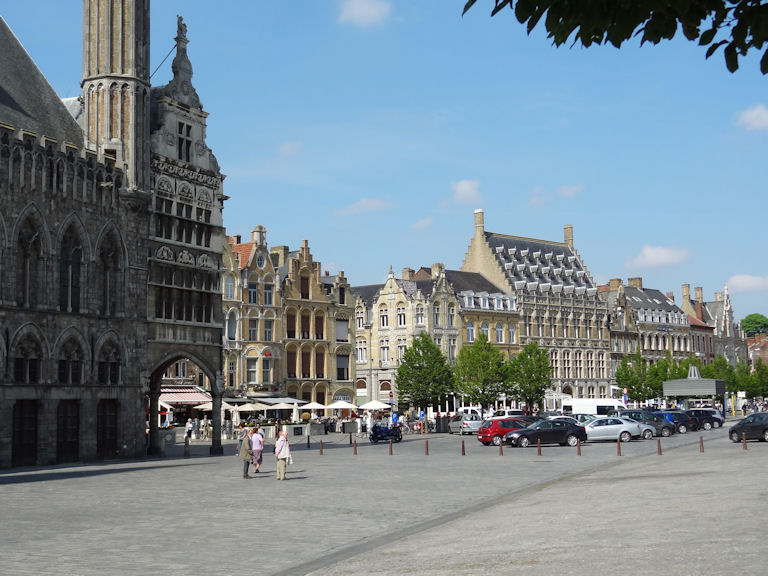
It’s very “foreign language textbook” I think …
I think I must have arrived about school-chucking-out-time as both the station area and the areas leading up the main square were populated with teenagers lurking around waiting for buses home!
After beer, I wandered up to the Menin Gate again to have a proper look around (a marble arch lined on virtually all sides with endless names), before having a slow walk up and down the ramparts. Again, once I headed out of the main square I virtually didn’t see another soul, and all was peaceful and quiet. Ypres does have tourists (and Tyne Cot was full of English people, many in tour groups but many more coming individually or, interestingly, in family groups. “Hey kids, I know a great place for a day out!”, although interestingly they were all pretty respectful!), but like tourists tend to do, they keep to the central areas where they know. And where there are cafés.
After visiting another small cemetery, I headed to a really nice restaurant where I had some traditional Flanders food. It was really nice (not just the food but the ambiance of the restaurant), however I ended up having to rush it down a bit too quick because I needed back to the Menin Gate for the 8pm ‘Last Post’ ceremony.
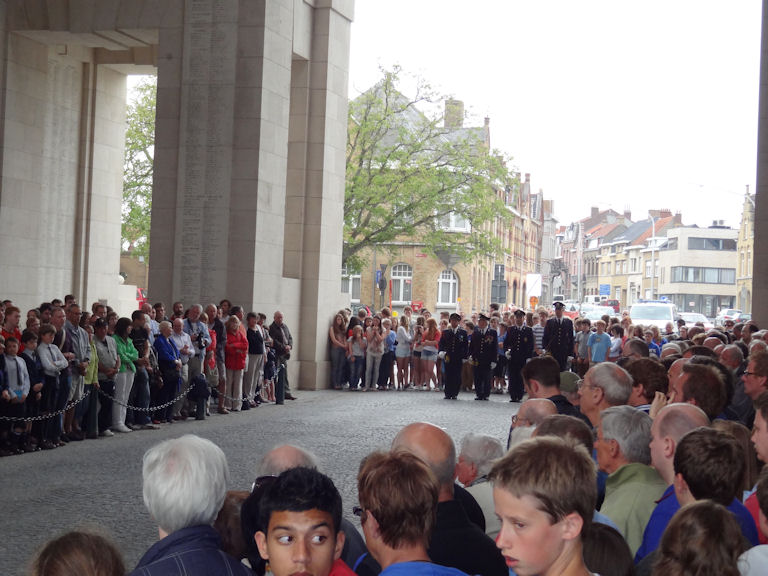
We will remember them.
It’s quite hard to describe this. At 8pm every night, they close off the road that runs under the Menin Gate. There then follows an almost ritualised scene whereby buglers sound ‘The Last Post’, then invited people place memorial wreaths in a certain part of the arch (when I was there it seemed to be mainly some children from several British schools!), after which the buglers play the ‘Reveille’ before everyone departs and they re-open the road. There’s often a big crowd to watch this, who are respectful throughout. It’s just a reminder about what happened here. They’ve been doing it every night it’s been logistically possible since 1928. Quite moving – I think a lot of people watch precisely because it’s a tourist attraction now rather than primarily out of respect, but it’s still very respectful.
Limped back to the market square to catch the bus back to Roeselare, which was almost empty. Caught the train back to Bruges and then, grumbling at the lack of the specific bus that headed back to the hotel, staggered back along the canal in the glorious dusk (it was marginally more comfortable barefoot on the paving). Had the home-brew and went to bed! And at no point did I see any poppies anywhere …
——————————————————————————
Today’s beer-tasting notes:
St Bernadus Abbot 12º : Another 10% beer, tastes a bit like traditional beer from the 1970s. Slightly watery texture, dark, but with that hoppy and slightly fruity flavour. Definitely full-flavoured.
Degraeve Dark (home-brew) : The only notes I have on this were that it was nice, chocolatey, and more-ish!
Day 3: Saturday 2 June –
Put Some Clothes On!
It’s a nice little set up at the “hotel”; at an agreed moment in time, Marjan would come upstairs and put on top of the little fridge outside a covered tray with bread in it, and make sure the fridge had things like soft cheese and jam. I’d then be able to take as much or as little as I wanted for breakfast. This morning, breakfast arrived at 9am and was heartily eaten.
After another chat with her about her hotel and how/why she started (20 years ago she was working in a café; one of her friends came up to her and asked if she knew anywhere she could stay the night. Marjan gave her the keys to her house, and she’s been in the hotel business ever since!), and also about why they started to brew beer (the queues to get hold of the mythical Trappist beer ‘Westvleteren 12’ from the abbey got so long that they thought they might as well start brewing their own!), she drove me to the station again in order for me to catch my train back to Brussels.
One of the many features of Continental trains in general is that they are often double-decker trains. To a Brit, this is exotic and strange (although they were experimented with many years ago, in Dorset or Sussex or somewhere equally obscure), but the concept works much better on the Continent than here. For one thing, station platforms are much lower, so the train doors don’t have to be so high up. This in turn makes railway stations themselves look odd and flat. Anyhoo, it was a double-decker train that took me to Brussels. Obviously I went upstairs, just for the craic! Good views, too! Well, as good a view you can *get* of the flat Flanders countryside …
Got off the train at “Brussels South”; although not the most central station in Brussels (that would be ‘Brussels Central’ !), it has a convenient tourist information kiosk where I could buy myself something known as a ‘BrusselsCard’ that gets me free entry to many museums, as well as unlimited use of public transport. And my first use of it was indeed to transport myself across the Belgian Metro to near where my hotel was.
My hotel (with the optimistic-sounding name of ‘Beverly Hills’) was on the South side of the Brussels inner ring road, so a little out the way of the city, but that made it slightly cheaper. It wasn’t in too bad a location actually, lying between the restaurants at Porte de Namur and the fashionable boutique shopping on Avenue Louise. It’s obviously expanded recently as my room was in a separate building to the main hotel, a few buildings down the side-road, but that made it in a pretty quiet place, so I wasn’t bothered by any noise or anything.
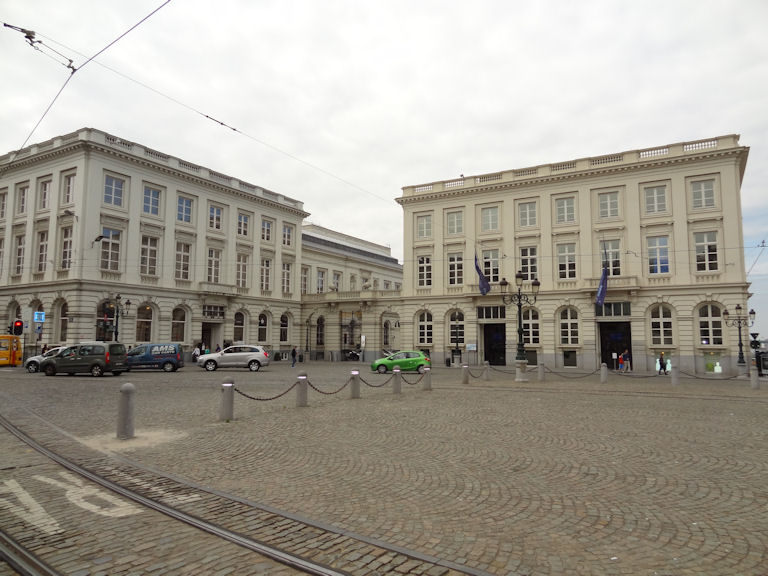
The art museums. Traditional and pretty buildings in and of themselves.
Then followed today’s museums, which had an ‘artistic’ bent. The Musée des Beaux Arts, the large art museum, with a varied selection of paintings but with a definite concentration on Belgian artists (oh yes, Breugel. And Rubens), but also a small collection of Modern Art. Roman Opalka, just, *WHY*?!?!
Connected to the Art Museum was the ‘Magritte Museum’ (which is indeed a museum, unlike one of the pubs he used to frequent that has the sign ‘this is not a museum’ on it), which on several floors takes you through the life and works of Magritte in a very interesting and thorough manner. On the lift up, there is a kind of small window through which on every floor there is an image of a part of a naked woman (as if the woman is 5 storeys tall). Somewhat amusingly, when I was in the lift, we stopped on the third floor to let one of the staff members out. You might well be able to guess what the drawing was through the window. Remember, I said ‘naked’ … !
Much of the rest of the day was spent wandering the city streets, admiring the buildings and the quirky sculptures and artwork scattered around, and also visiting a couple of cafés, obviously! Belgium’s most famous resident is the Manneken Pis, which is actually much smaller than you’d imagine. Seriously. Wikipedia says it’s 2′ tall, but as it’s in an alcove on a pedestal and not easy to get to, it’s hard to verify. If that’s not quirky enough, more recently he’s been joined in Brussels by the ‘Jeanneke Pis’ (a girl squatting), and more recently still by Zinneke – a dog cocking his leg up on a bollard. This latter is in the fashion district so that might be additionally symbolic :p.

See, I told you it wasn’t very big!
After visiting a respected but tucked-away bar (opposite Jeanneke Pis), I had some food in one of the street restaurants. On the TV at the time was the international football friendly between England and Belgium; my restaurant was almost completely empty and not even the staff seemed terribly interested (although one of the waiters cheered when England scored!). Contrarily, one of the bars nearby must have been filled with English tourists as the cheer from there was quite loud! Virtually no-one seemed to be supporting Belgium. This I found quite odd.
Another hidden but very nice bar was visited before I headed off on the tram and metro back to the hotel. It’s an efficient service, if a little ‘jerky’ at times. Back at the hotel I once again had connections connecting to wi-fi, but didn’t really consider it to be that important really.
——————————————————————————
Today’s beer-tasting notes:
Apple : The name kind of gives it away; it was only 3% so was more of a refresher than a proper drink, but it was quite ‘thick’ – not like a cider but more like a traditional cloudy flat appleade.
Delerium Tremens – a 9%-er, quite plain tasting though. Slightly fruity and hoppy, with a bubbly texture.
Rochefort (Brun) : Dark-coloured and sweet, with a ‘foamy’ texture in the mouth. Good, but not as nice as Pannepot.
day 4: Sunday 3 June –
Sandwell and the Ninth Art
Today saw the first justification for bringing my big rucksack. It rained. Lots.
Took an early Metro to the very edge of the city centre, to the suburb of Heysel. Apart from the Manneken Pis, the other ‘object’ that’s readily identifiable as being ‘Bruxellois’ is the rather odd Atomium – a series of interconnected metallic spheres that are supposed to accurately represent (although at several million times’ magnitude) the structure of an Iron atom. You can go up inside it and see good views over Brussels. It was around 10am on a very wet and grey Sunday morning, so I decided to forego that one!
After wandering past the distinctly unimpressive Stade Roi Baudouin (National Stadium), I caught the metro back into the centre of the city. Although not on the grand scale of Moscow, some of the stations on the Brussels Metro system have interesting artworks and are worth stopping to look at for a couple of minutes. Three in particular today that I passed through, I actually ended up (accidentally, as it happens) coming back to and getting on a train/tram *from* to go somewhere else. My journey from the Heysel area left from the first of these: Houba-Brugmann, with artwork laid out like a set of film slides of a woman dancing with a flourish. On my way then to Brussels Central, I passed through the second of these: Ste-Catherine.
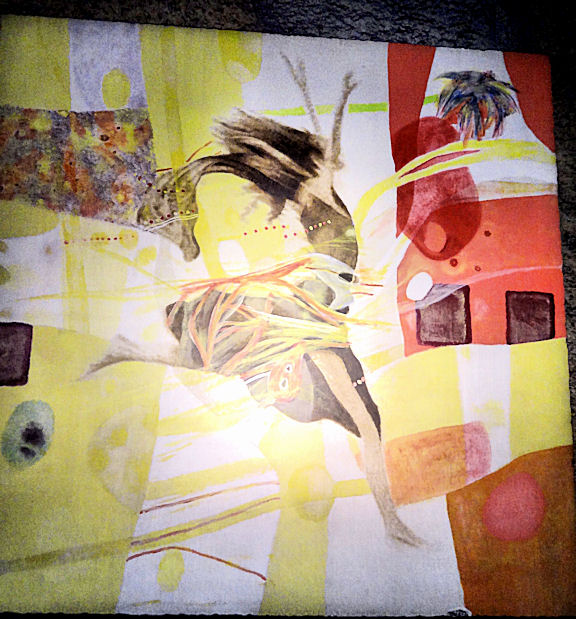
She starts off just stood and plain, and ends like this. The opposite wall is just as ‘motion-themed’ too, but with more people!
The rain had eased off for a bit by the time I arrived back in the centre, but my next stop was inside anyway. While this might sound incredibly boring, the National Bank Museum was actually pretty interesting – it detailed in simple terms what money was, where it came from, and why it was important. There were displays on money throughout the ages and the world, and then displays and even audio-commentaries on different aspects of money and monetary policy (eg what a Clearing Bank does, what Inflation actually means, and the like). The building it’s in is actually the Bank building, and the initial rooms were originally used for Bank meetings!
From the Bank Museum it was a short walk to the Centre Belge de Bande Dessinée. This ‘museum’, built on several floors, displays extracts from all manner of cartoon strips, and has a very in-depth biographical section of many of the area’s most famous and influential cartoonists, complete with examples of their work and items from their studios (so you get to see, for example, the desk layout that Marc Sleen would have used). Many famous cartoon creations are present, including mini statues of creations like Lucky Luke, Tintin (of course!), and, although not mentioned anywhere within the centre itself, Asterix.
Comics, also known as the Ninth Art (one wonders what the other Eight are!), has always been very big in Belgium – to be honest it’s big across Francophone Europe, although there is a strong Dutch contingent too in Belgium (including Sleen and Willy Vandersteen). “Comic” and “Cartoon” are sometimes seen a bit of loaded words in English, as they imply ‘drawings for kids, usually with comedic effect’. While many of these Belgian cartoonists do draw/write to create ‘laughs’ amongst the readership, they are often satirical, parodic, and with adult themes and jokes. It’s a serious art form, and indeed the phrase ‘ninth art’ can be seen to demonstrate the ‘artistic’ nature of them not just the content.
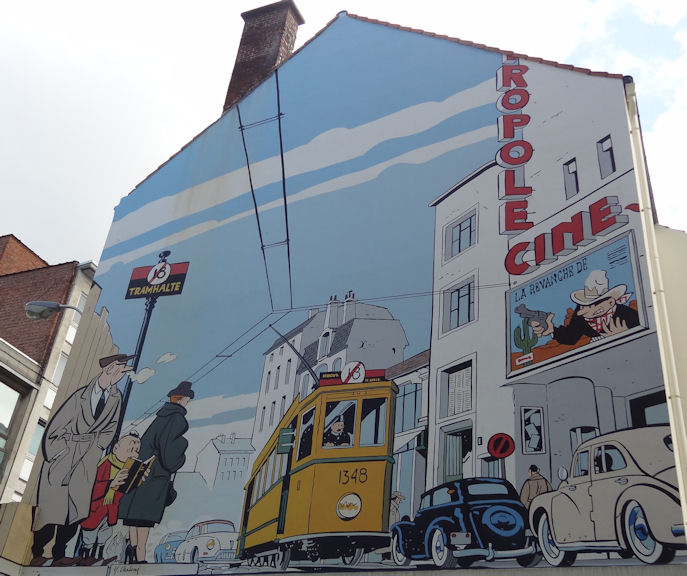
Cartoon mural in Brussels, of Brussels.
“Comic Art” is not just restricted to the museum and the bookshops, either. Brussels is noted for its ‘comic murals’ – mainly on side streets – where an otherwise blank wall has been (officially!) drawn on with a comic scene or a piece of drawn artwork, usually by famous cartoonists or at least in their style. Some of them are humorous (one tall thin wall has a boy at the top dropping something out of a window that’s hit a man walking at ground level), others are artistically scene-setting (one has a very 1920s American ‘film noir’ feeling of a well-dressed man and woman leaving a bar at dusk). The free maps indicate where roughly they are, but not what they are, and some of them are subtly hidden and take some finding (one, near Brussels South station, is on a blank wall about three storeys up and takes a lot of peering. It’s a surreal one of a bricklayer building the wall that he’s drawn on. Oh, and the bricklayer’s a cat (it’s an example of one of the more famous cartoon strips in Belgium – one-panel surrealist gags with the central character being an anthropomorphic cat).
After having some not-that-great frites with mayo, I went back to the pub I ventured into yesterday, for a casual (and expensive!! See below!) beer, before taking a wander through the Western side of the city centre, along quiet streets with murals and other weird things, including the Zinneke – a sculpture of a mongrel dog cocking his leg up on a bollard. Because obviously the Mannekin Pis and the Jeanneke Pis just aren’t enough for this urologically-obsessed nation! (Educational note: ‘Zinneke’ is a nickname for people from Brussels, and originates from the name given to the stray dogs that congregated around the River Zenne in the city). Other weird and wonderful sculptures in the area are the Anspach fountain, complete with crocodiles that look like they’ve been captured in mid-dance, and the nearby statue to commemorate some of the brave but oft-forgotten soldiers of WW1 – yep, there’s a memorial here to the War Pigeons.
Got on the metro at Ste-Catherine stop, which I’d passed through earlier. Had some technical problems with swiping in, as I think I went in through the out door and then my BruxellesCard wouldn’t work (because it said I’d already swiped in, but I was still outside the gates!), but a managed to tailgate a group of young Americans going back to Barcelona. Ste-Catherine is decorated with colourful drawings of flowers, which I thought was quite nice.
My destination was the EU area, but first I passed through the Cinquantenaire, an arch (similar to the Arc de Triomphe) built to commemorate the 50th anniversary of the creation of Belgium. And it was indeed completed in time for the anniversary. The 75th anniversary … [how these guys hosted Euro 2000 I’ll never know!]. The arch is surrounded by grand buildings that are mostly now museums, and opens out onto a large parkland area where they host events (they were setting up for one when I wandered through). At the Western end of the park is a monument to the Belgian adventure in the Congo River area, a part of Belgian history that these days they’re a bit embarrassed about …
The EU area itself is … modernist. The European parliament is very ‘windows and fibreglass’, it’s not something I could imagine very easily people wanting to take home replica models of. Due to it being occupying both sides of a narrow road, and being quite tall, it’s also quite a hard thing to take a picture of! It backs onto a landscaped parkland area, you only really see the back of the many buildings. The park itself has other buildings that surround it (including a school and a museum). On the pavement walking towards the buildings, the stars of the EU flag are painted in blue. Iconic branding, if maybe slightly dull. It was a Sunday late afternoon, so there wasn’t much going on!

The back of the debating chamber of the EU Parliament – the Paul-Henri Spaak building
Hopping on the metro at Maelbeek, the third station I’d passed through and thought ‘hmm, quirky’ – the artwork here on the station walls took the form of simply-drawn outlined heads in a rather modernist style, I headed back to the hotel for a rest. Wi-fi still not working, but one of the staff came with me and we isolated the problem to be with the router probably being loaded with the wrong password, rather than anything with my phone!
After a bit of a rest, I popped out to grab some food in the centre of town. I ended up at a decidedly ‘English’-feeling place called ‘Falstaff’, in the Bourse area, although housed in a rather ornamental building. Today’s Belgian foodstuff was ‘Carbonnades’ – beef stew in beer. Came with frites, much better frites than from the street stalls, incidentally! No mayo, but bread rolls. As I was eating, there was some music playing outside, from what I imagine to be a reasonably high-quality busker, and I noticed two tourists-with-small-rucksacks and umbrellas suddenly start dancing in the street outside to the music. How quirky, and terribly Bruxellois!
And that’s what I feel about Brussels. It’s a bit like Paris, but with less people, less focal points, and a more ‘laissez-faire’ charm. It’s a bit ‘grittier’, not as polished, but I think all the better for that. It has a style that’s understated and less ‘full-on’ than Paris, but it’s definitely a lovable place.
Although my main gripe is the maps don’t show the tram lines, apart from the city-centre portion of two of them. This had me then wandering around the city centre trying to find the stops for the tram that could take me back down Avenue Louise much closer to the hotel. I knew it existed because I’d seen it at Louise, I just didn’t know where it went … eventually found it, three stops from home, after wandering past more very quirky artwork (this time, a set of footprints painted on a stairway that started from the bin at the bottom!). But still, three stops is better than walking all the way!
——————————————————————————
Today’s beer-tasting notes:
Westvleteren 12 : “The World’s Best Beer” (and at €10, it had better be!). Dark-coloured, light-tasting, quite mellow, ‘foamy’, with a slight raisin aftertaste. It grows on you, but I *still* prefer Sarah Hughes’ “Dark Ruby”!
Chimay Bleue 90 – Very floral, light-tasting dark beer, quite hoppy with a slightly metallic note.
Day 5: Monday 4 June –
Pretty Small Towns
On Mondays, museums tend to close in Belgium. When planning this trip, this gave me a problem as to what to do today; my initial thought had been to visit the Waterloo battlefield, just south of Brussels, before heading straight into Luxembourg (because it’s a 3-hour journey) but having already seen rather a lot of much more interesting and detailed battleground sites on Friday, I’d decided to have a rethink, and noted that there was more to Luxembourg than just Luxembourg City. Although not terribly much more, given that it’s the 179th largest country in the world (1,000 sq miles / 2,600 sq km – for the Brits this makes it marginally smaller than Oxfordshire and Derbyshire. For the Americans, this makes it 200 sq ml smaller than Rhode Island. For the Aussies, it’s slightly larger than the Australian Capital Territory. For the French, it’s the size of Luxembourg, Jeez!!).
Anyhoo. Got up early, but didn’t actually need to have done. Had breakfast in the hotel – there’s something about continental breakfasts that you think ‘yeh, there’s not much to them’, until you actually start *eating* them. Bread overdose!! – before heading off to the city centre, purposefully by tram so that I know next time where the tram goes from! Of course, naturally, I couldn’t find the way from the tram stop to Brussels Central railway station, even though it’s only two blocks away … Gaaah!
Tickets to Luxembourg are classified as ‘International Destinations’ which, while blindingly obvious, is still strange as it puts Luxembourg on the same tier as places like the UK and Germany, whereas in practicality it’s a casual couple of hours down the track. My ticket to the obscure town of Ettelbruck cost €45 single, or €41 return. Yeh, I thought it was just the UK that had weird rail-pricing policies. I got a return – the lady said I could use the money saved for a “free beer” lol!
Most people who go from Brussels to Luxembourg City do so on the hourly direct trains. However I was aiming for the far East of the Grand Duchy, and for that I needed to change in the city of Liège; this would be my first (and in fact only) venture into Wallonia. The train was a few minutes late, switched platforms, and was packed – although this latter point resolved itself at Brussels North station when everyone got off … The suburban stations we passed through at high speed were all quite odd – rather than having an open platform, they had a wire fence separating one side from the other, with a gateway every so often down the platform. Odd.
Now here I ought to mention something odd about the trains that sums up the Belgian Compromise. Remember, Belgium is a bi-lingual country in the sense that the two main halves of it speak different languages. On the trains in Flanders, all the announcements are in Dutch. When Flemish trains arrive in Brussels, the announcements are then made in both Dutch and French. The train I was on (which presumably originally started in Kortrijk or Bruges) passed out of Brussels and back into Flanders (so arriving in Leuven, all the announcements were only in Dutch). The next stop after Leuven was Liège, which being in Wallonia, is Francophone, so on arrival, the train announcements were only in French. Confused? You will be … !!
Liège (Guillemins) station is … ‘architecturally modern’. By which I mean it has no straight lines, and looks like a cross between the fancy wing shapes often seen on cupcakes, and the Starship Enterprise. It’s quite a way out of the city centre, and the area outside looks like it’s still being built. I had an hour and a bit to waste, so I wandered through a bit of a grubby suburb to a small area with shops and a couple of cafés (it wouldn’t have looked out of place in some small suburb of Birmingham), where I had a mid-morning chocolate chaud.
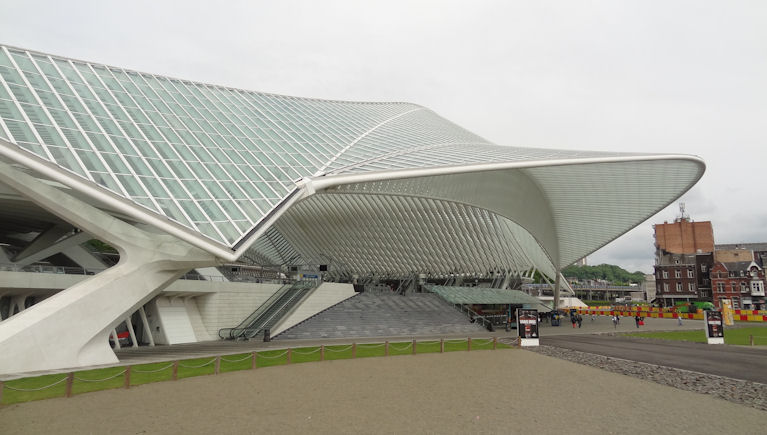
By ‘Architecturally Modern’ I mean ‘weird’, obviously!
The train from Liège to Luxembourg is roughly every 2-hourly, and by the feel of things, not particularly well-patronised (I got that impression on most of the trains in Belgium actually – they’re not terribly busy!). The scenery en-route was very different to that in Flanders – this is the Ardennes and it’s definitely prettier, with forests, hills, rivers, tunnels … parts of the route actually reminded me a little of the A6 at Ambergate in Derbyshire, with a river valley clearly visible in front of tree-covered hills. The countryside was occasionally punctuated with evidence of industry – mainly quarrying and construction. The other interesting point to note is that much of the journey was *single-track*, which for an ‘international’ train line, is very odd to contemplate! It’s actually very reminiscent of the ‘Heart of Wales‘ railway line.
At Gouvy, the last station in Belgium, some chap got on and tried to guess which language was my preferred option, before giving me a cross-border-traffic customer survey which he picked back up at the first station in Luxembourg (Troisvierges). It was here that more people started to get on – it’s one of the simplest and easiest ways to get to civilisation from the edges of Luxembourg I guess. In addition, the train announcements started to be made in German as well as French.
Got off the train at Ettelbruck, a small town with a nice café on the station platform where I bought myself a little pastry for lunch. Also bought a ‘Luxembourg Card’ that got me free entry to 50-odd museums and places, money off others, and free public transport, for between 1-3 days. (As a side note, it’s interesting to note that whenever I try to speak French to, say, a shop-assistant, they always reply in English. Is that *that* obvious?!) From Ettelbruck I caught the train to Diekirch – only 5 minutes away so the double-decker shuttle train service might seem a bit of an overkill, but *some* of the trains from Diekirch do go all the way through to Luxembourg City.
Diekirch was also quite a small town, and the railway station was right next to the ‘bus station’ – which was actually two sides of a lay-by with several stopping points for buses but only two direction signs. Wasn’t sure what bus to catch onward (though I knew they were regular), so in the process of checking and then taking pictures of the small community-representative sculpture in front of the station, the bus I wanted left … meh. Had to wait half an hour for the next one, during which time Diekirch station flooded with teenagers – evidently school must have finished for the day at 2pm.
By bus, I mean something more reminiscent of a coach, but the next one eventually came. I was headed for the hillside town of Vianden, famous for its old castle and for being the base for much of the area’s tourism (it’s got a theme park nearby, as well as good hiking through the forests). Vianden is also only about a mile and a half from the German border so if I hadn’t had a dodgy leg, and the road there hadn’t been very winding and uphill, I might have just walked there, just to say that I had. But I didn’t. It’s a very pretty town; the “bus station” was right next to the hotel I’d booked into, which was somewhat convenient since it meant I didn’t have to find it …
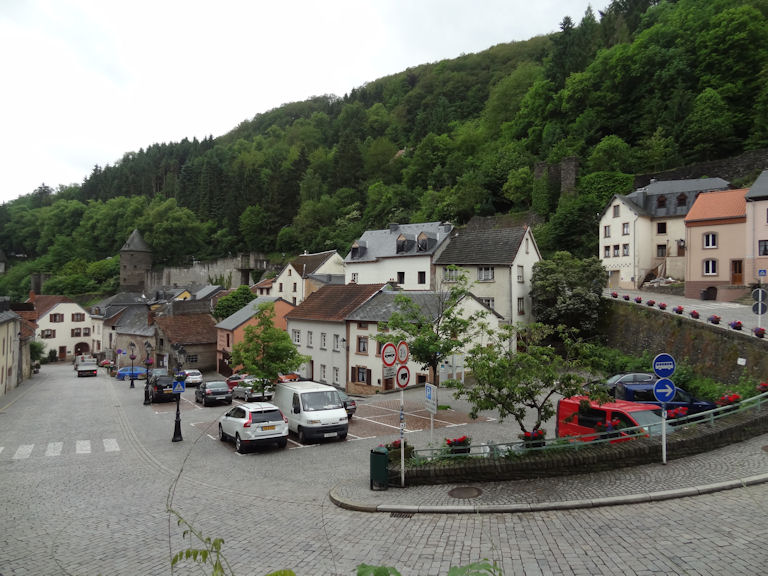
Vianden town centre. Pretty, isn’t it?!
After checking in (a very nice hotel, with a very large room!), I had a short rest before exploring Vianden town. My first point-of-call was the chairlift. Yeh. The castle stands high above the town on the opposite side of the river, and to get up the hill you can either walk or you can take the chairlift. Exactly as it sounds; it’s a chair (or in fact more like a bench) attached to a wire that goes up and down the mountain. It’s very ‘open’, and it wiggled from side to side if you move. Safe as houses, obviously. It did give a fine view over the river valley and up towards the castle, but I’d imagine the views were better going ‘down’ as at least then you’re going in the right direction.
At the very top of the chairlift was a café, which I was almost tempted with (as I’d hardly had anything to eat all day), but decided against it as when I got there, it had started to rain very badly, so decided to head straight for the castle. This involved staggering down a forest path for a couple of hundred metres (the chairlift gets you to a point higher than the castle), which was more precarious than Kbal Spean, partly because the latter didn’t involve rain or walking sticks …
Vianden Castle then. It’s old – there’s been something here since late Roman times, and expanded over the years. It used to be one of the homes owned by the House of Nassau, one head of whom was William of Orange – victor of the last successful ‘invasion’ of England. However, in the years following the Napoleonic Wars, Vianden was kind of ‘forgotten about’. The castle eventually was sold essentially for scrap, and lay in a state of disrepair until the 1970s, when a campaign was launched to renovate it. These days the castle is a museum; inside, you get to see the history of the castle (including a cut-away of a cross-section of ground where you can see the imprint left by some of the older walls), as well as a few of the rooms which have been displayed as they would have been when it was used as a royal house. You actually get to see quite a lot of the inside of the place, and you certainly get the impression of the richness and size of the place.
Once out of the castle, I had a wander around the quiet street (one main street, a handful of side-streets) for a café, but none were serving snacks and it was a little too early for a main meal. I ended up having a grillwurst. Because a hot dog is what you need for lunch at 5.30pm … didn’t give any to the house dog either, a miniature poodle called Zoubi.
Went back to hotel to recover from the walking, and to plot out what I should do tomorrow, before heading back out in the evening light to grab some food at the Victor Hugo hotel and restaurant. (There’s also a Victor Hugo museum here, and a small statue of Victor Hugo by Rodin at the bridge over the river – apparently he lived in Vianden for a *few months*; ‘dead horse’ and ‘flogging’ spring to mind.) The restaurant radio was playing some local Luxembourg radio station, on which a very stereotypical-American-accented DJ playing some strange stuff (for the location), including a mash-up of ‘Riders on the Storm’ and ‘Rapture’. Very odd.
Took time to amble slowly back to the hotel, in the fading evening light, making the quiet town look very pretty. Apparently in summer it’s invaded by motorbikes (like Matlock Bath), and it’s often full of tourists anyway, but it felt very quiet and empty when I was wandering through. The buildings are very pretty and the sculptures make more sense than Belgium (one is of a series of musicians, as, after Vianden castle lost its influence in the 1820s, there was a large exodus from the area into the bigger towns. A small troupe of musicians started up, and toured the local towns and villages, like Vianden, to raise the spirits of the people and encourage them to stay).
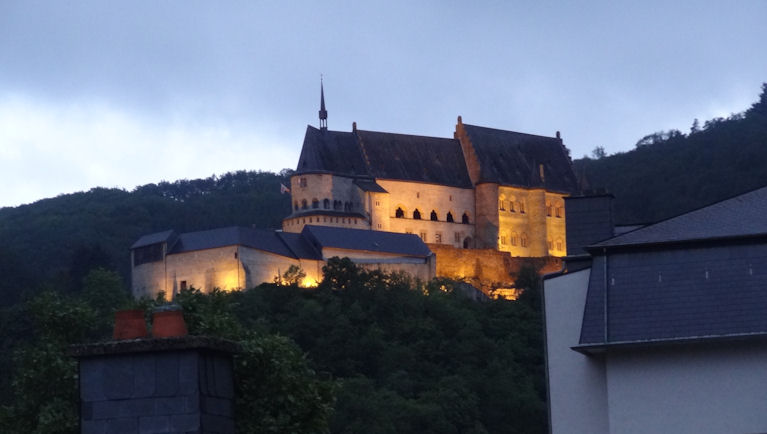
Vianden castle by night, nicely floodlit.
——————————————————————————
Today’s beer-tasting notes:
Leffe – brun : Dark-tasting, caramel-like, sweet but still rich flavour, maybe roasted? ‘Drying’ too, not a mild or a stout.
Day 6: Tuesday 5 June –
If it’s Tuesday, it must be Belg…oh, hang on…
Today felt like a Saturday, probably because it was the second-to-last day of my trip. This is better than back in England, where it would have effectively been the third Sunday in a row :p
Caught an early bus to Diekirch, and had a chocolate chaud for breakfast. The trouble I’ve found with Luxembourg is the relatively late starts; museums and places tend to open around 10am. Since many of the buses are hourly, this means that before you know it, it’s lunchtime, so it’s not as easy to have mad-packed days here. Today’s 10am museum was the ‘Military Museum’, carrying on the theme from Friday; this museum however is dedicated to WWII – specifically the ‘Battle of the Bulge‘.
Historical note: This part of Europe was scene of great fighting over the Winter of 1944-45; the Germans believed they could break the back of the Allied forces by splitting and surrounding them, which would lead to a peace deal, leaving them to concentrate on fighting the Soviet Union. They failed, although partly through the terrain and the weather as well as through Allied resistance (it was very snowy), although certainly Allied bloodymindedness helped (“Nuts”, indeed). The majority of the action on the Allied side came from American forces, and it was also notable for being pretty much the first conflict where African-American soldiers fought alongside white soldiers.
The museum was pretty intricate and full of detail, from all sides of the conflict but predominantly promoting the American line. Outside the museum were replicas of several vehicles used in the conflict (including a tank), and inside one of the larger rooms was filled with all manner of vehicles and machinery of the battle, for example army jeeps, motorbikes, missile-launchers, etc. Other rooms included a recreation of a German hideout, an overview on what had happened to the local population on the German’s original advance, and rooms with all manner of documentation and items from the period (adverts, newspaper clippings, personal effects, etc). Lots of detail, very thorough, but couldn’t help but feel I would get the best out of it if I were a generic patriotic American!

Recreation of a typical scene amongst the forces at the time. Notice the snow; there are signs saying ‘Don’t Eat’!
From Diekirch I ambled slowly back to the station and caught the train to Ettelbruck – still a double-decker for a 5-min journey – and from there a connecting service into Luxembourg City. My ‘Luxembourg Card’ came with a list of all the sites that got me free entry. Many of them up in the North of Luxembourg had erratic opening hours or were only open in very high-season, but in the nearby town of Larochette (not to be confused with La Rochelle, which was a long time ago in a galaxy far far away!) there was another château (as well as that). I’d toyed with the idea of going to the castle at Larochette, but firstly I’d got my large rucksack with me, but, more decisively, I arrived at the bus station about two minutes after the hourly bus to Luxembourg via Larochette left …
The train arrived into Luxembourg on a viaduct, which supplied good views over the city. Quite a nice station, nice frontage and reasonable size without being large (a bit like London Marylebone). My hotel was about 300-400 metres from the station, down a road of seedy bars and dodgy takeaways; very typical for the area around a station! Despite being directly above a (dodgy-looking) bar, the hotel room was actually pretty nice. In addition, the receptionist actually spoke to me in French rather than English when I checked in; proving that I *can* pretend that I’m not a dumb English tourist ……
Luxembourg City can be unofficially divided into several ‘segments’; the area around the station is separate from the main city centre by a very steep river valley (the small Petrusse River), in which are parklands, walks, and some buildings. On the other side of the old ramparts to the East, heading down towards the valley, is an area of quiet cobbled streets and interesting cafés To the North-East, over the Alzette River, lie the main bulk of the banking offices and the other parts of the European Parliament. The Petrusse valley is very pretty indeed, as city centre river valleys go, and the remains of the fortifications provide some good views on the other side.
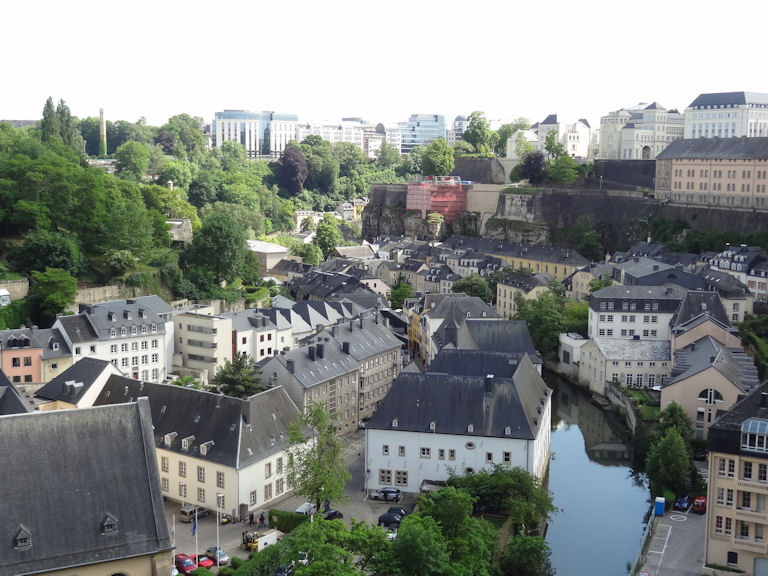
View overlooking the quaint café area. Ever seen a capital city this pretty?!
It’s a very expensive country; the hotel was the most expensive I stayed in on the trip, despite its location, and food and drink are more costly on average compared with Belgium. However the locals don’t notice; it’s one of the richest countries in the world (it also has amongst the lowest-priced petrol in Europe – the French, Belgians, and Germans often cross the border purely to fill up!). While these days Luxembourg’s affluence is built on the finance industries, its wealth was originally created by iron and steel, and the offices of the largest steel companies in the world are still in the city centre.
I spent a picturesque but wind-swept 45 minutes on a hop-on/hop-off bus tour around the city; some of the streets in the Old Town just aren’t designed for double-decker buses! In addition, some of the trees on the avenues we went down were a little too close for comfort for an open-topped bus, and we came close to a headbutting incident on several occasions! The city’s not that big, relative to other cities I’ve been to, but the EU buildings still felt like a long way from the city centre! (And, in fact, are very close to the edge of the town – I did see quite a bit of countryside on that part of the route!).
For lunch I grabbed a baguette and a pastry from one of the open-fronted shops not far from the main square, before having a look around one of the museums – the MHNA (National Museum of History and Art). Quite a weird building – 10 floors (although a couple were being renovated), but each floor in itself wasn’t terribly large. It’s a mixture of history and art; the floors below ground level all dealt with the history of the local area from prehistory to the Middle Ages (each floor was a different historical period). One of the highlights was an incredibly large and very well-preserved Roman mosaic that you could walk around on one floor, or go to the next floor above and look down at it from above. The upper floors were mainly about art (mostly religious European art from the post-Renaissance era, but with some Modern Art too); the very top floor was a special exhibition about archaeology, but while it told you about archaeological practices, much of the historical stuff they talked about (Roman towns in Northern Luxembourg) was a rehash of what was on the lower floors (where they had, for example, a model recreation of several pre-Roman houses and buildings in a ‘town’).
After the museum, I made the short walk further towards the ramparts to visit the Bock – man-made caves under the rocks that the city is built on that have, over the years, been used for industry, storage, and, latterly, defence The fortifications were dismantled in 1867 as part of the peace treaty that led to Luxembourg being confirmed as an independent Duchy, but quite a lot of the caves were never filled in. Some of the passages inside are quite wide, and cannons have been placed in the ends of cave passages that open out over the city, so you can look out and see what they would have fired at! The only part I didn’t visit was the deep passageway because it involved going down a very narrow spiral staircase, which wasn’t terribly practical with a stick!
After a slow wander around the ramparts, and then going down into the quaint café area (the pub I wanted to go to hadn’t opened for the evening yet, gaah!), I went through a weird passageway of Primary School Art, and then took a *lift* back up to the main town area – bizarre method of transportation but incredibly useful. Sized up the square-side restaurants for an early-evening snack, but slightly out off by the price so headed a bit out the way to the “Art Café”, a quirkily-decorated place where I devoured a croque-monsieur. Then I headed back to the hotel (by bus!) for a rest, via a café for a beer!
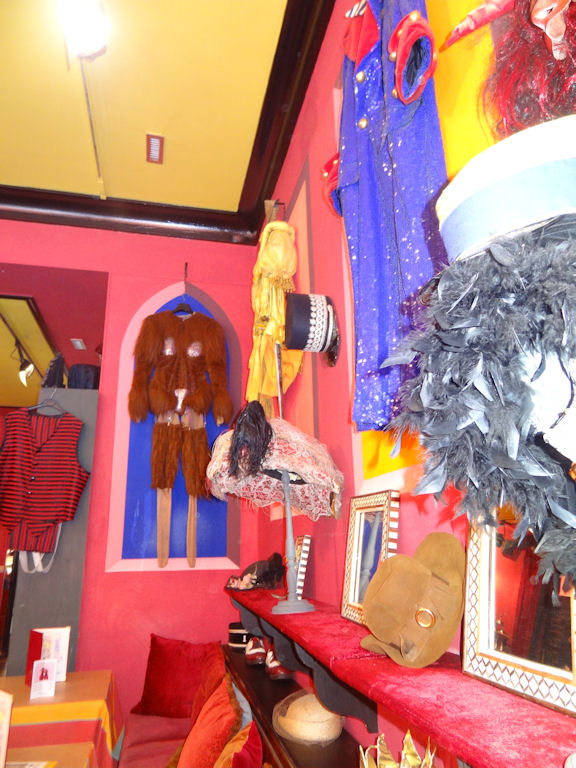
The Art Café Definitely interestingly decorated!
Had a mid-evening wander around the area around the hotel for something to eat, but nothing really took my fancy. I ended up in a small pizza place opposite the railway station about 10pm where I had a couple of slices of ham/mushroom pizza and, yes, a chocolate chaud! Despite the hotel being in an area of seedy bars, I didn’t notice too much noise at all overnight.
——————————————————————————
Today’s beer-tasting notes:
Orval : Fairly dull, foamy, slightly malty, indistinct.
Day 7: Wednesday 6 June –
Trans Europe … Branch Line Stopping Service
It rained again.
I’d been musing about what to do today. Two places sprang to mind; Larochette again, or Schengen, but the former would have left me with an awkward time-restricted journey back (because the train’s only every 2 hours back into Belgium on that line), and the latter was do-able but required a change of bus in either direction with about a 5-minute leeway, which is pretty comfortable in small Benelux towns but I didn’t want to risk it. So I figured I’d go back to Brussels and drink beer before my train back to England left.
After tripping into the city centre to post a postcard and a gift, I headed back to the hotel, picked up my bags, and went to the station (via a patisserie). As I’d got a specific return ticket for the line through Liège, it made sense to take the longer route back that way rather than pay for the ticket on the other line from Luxembourg to the Belgian border town of Arlon (my Eurostar ticket being to/from “any Belgian Station” meant I could have used that ticket from Arlon).
Although there were a reasonable number of people on the train when it left Luxembourg, it practically emptied completely at Ettelbruck (but filled up again at Vielsalm). The ‘doors closing’ ‘jingle’ on the train sounded remarkably like a badly out-of-tune childrens’ bugle …
Got into Brussels with several hours to waste. First stop, more frites (it was lunchtime) – this time with something mysteriously known as ‘samurai sauce’, which was orange and slightly spicy. Your guess is as good as mine, but at least it wasn’t wasabi … Once eaten, I made my way over to another of those quirky backstreet bars that are hidden away – this one was “Estominet, Theatre Royale de Toone”; it was the bar of the puppet theatre, whose current production in the evenings was a modern, Belgian, marionette take on Hamlet. Set in Ostend. * shrug. Anyway it was a very interestingly decorated pub, quiet too, barring the occasional small tour party coming to take pictures of the inside of it!
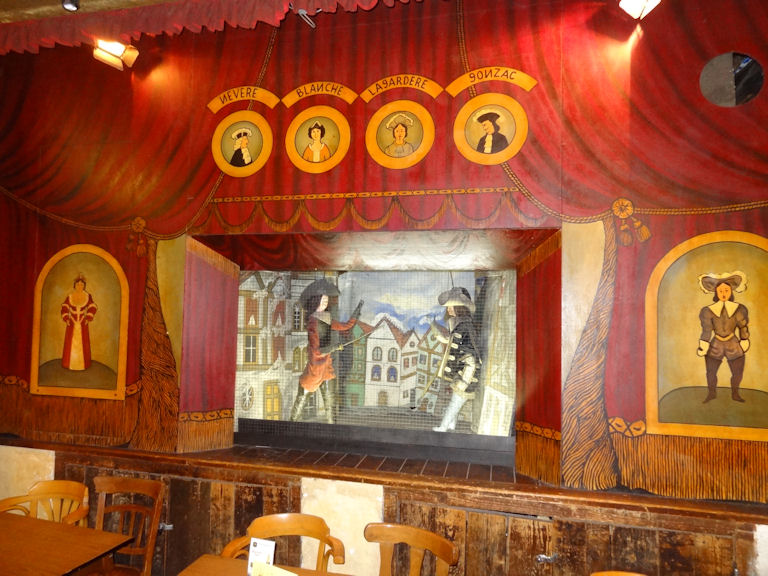
Marionette theatre display. In a pub. Hey, it’s Belgium!
After the pub, the beer. Went into a large beer shop to pick up a few bottles of decent Belgian beer to take back home; I can get some of it back in England (there’s a pub at Sheffield railway station which sells them), but they’re considerably more expensive back home. Plus this way I can have them when I want; also, that particular pub also does many beers on draught, which I prefer anyway. #BeerSnob.
Spent the rest of the time on a slow wander through the streets between Brussels Central and Brussels South railway stations, passing by as many of the comic murals as was realistic to on the map. On the way I also passed Brussels-Chapel railway station, above which is a skatepark. Given it’s overlooked by Brussels’ oldest-surviving church, it makes for a very weird juxtaposition all round really!
Upon arrival at Brussels-South, I realised I’d lost my ticket for the journey back home from London to Nottingham. This was awkward as a) it was First Class, and b) it was only £23. So I figured buying a new standard ticket would be quite expensive. No idea where it went, but I suspect I probably left it in Bruges when I first scattered all my stuff around. Gaaah! Anyhow, checked into Eurostar fine (coming into Lille Europe was a bit odd, as ‘ground level’ was about the same as the bottom of the window, so I had a very strange mouse-level view of the main square outside the station!), and had a pretty comfortable journey back into England. Had great difficulty getting any kind of Internet network on the phone on the train back in England, which was a little frustrating as I was trying to source my original ticket reservations for the journey back home.
In the event, it didn’t matter as they needed to see a proper ticket and they couldn’t reissue the ticket without some indication of payment. Grrr. £55. Meh. In addition, the train was absolutely packed to the rafters, and the reservations weren’t being displayed so the whole thing was a chaotic nightmare. Stood up till Leicester.
Caught a decently-timed connection in Nottingham to Kirkby-in-Ashfield so, after a taxi from the station, was back home by 10.45pm. First action (after turning on my electricity!) was ordering a takeaway. Yum!
——————————————————————————
Today’s beer-tasting notes:
Westmalle Blonde : light, very hoppy, foamy, slight cereal notes, smooth. Slightly sweet but not overpoweringly so.